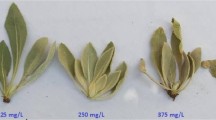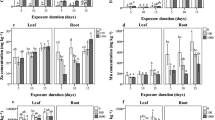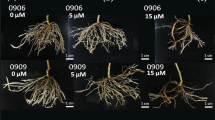Abstract
The mechanisms enabling plants to tolerate high concentrations of available Cu in their rhizosphere are still poorly understood. To better understand the mechanisms involved, Lupinus albus L. (white lupin) was grown over 40 days in a hydroponic system compelling roots to develop under sterile conditions in the presence of a nutrient solution containing 0.5, 20 or 62 μM Cu. The following parameters were investigated in detail: low molecular weight phenols in nutrient solution (colorimetric assay), high molecular weight phenols in roots and in solution (HPLC-MS, HPLC-UV), pH, redox potential in solution (electrochemistry) and Cu distribution in the plant (AAS) as well as in apical root sections (EDX microanalysis). Finally, in vitro adsorption studies using voltammetry were conducted to evaluate the Cu adsorption behaviour of different phenolic compounds. When exposed to 62 μM Cu, biomass production of white lupin was strongly reduced. Plants grown in the presence of 20 μM Cu had a similar dry matter production compared to the control plants grown in a 0.5 μM Cu solution. However, an increased release of soluble and high molecular weight phenols into the solution was observed. The concentration of polyphenolic compounds in the roots (particularly isoflavonoids like genistein and genistein-(malonyl)-glucoside) was significantly higher for lupins grown in a 20 μM Cu solution compared to the control plants. As shown by an in vitro adsorption study, these phenolic compounds can bind Cu ions. In addition, plants exposed to 20 and 62 μM Cu cumulated high Cu amounts in root cell walls whereas only low amounts reached the symplasm. Therefore, it is proposed that the complexation of Cu2+ ions in the rhizosphere and in the roots apoplasm by phenolic compounds could alleviate Cu-mediated toxicity.
Similar content being viewed by others
References
Archambault D J, Zhang G and Taylor G J 1996 Accumulation of Al in root mucilage of an Al resistant and an Al sensitive cultivar of wheat. Plant Physiol. 112, 1471–1478.
Bednarek P, Franski R, Kerhoas L, Einhorn J, Wojtaszek P and Stobiecki M 2001 Profiling changes in metabolism of isoflavonoids and their conjugates in Lupinus albus treated with biotic elicitor. Phytochemistry 56, 77–85.
De Vos C H R, Schat H, Vooijs R and Ernst W H O 1989 Copper-induced damage to the permeability barrier in roots of Silene cucubalus. J. Plant Physiol. 135, 164–169.
De Vos C H R, Schat H, and De Waal M A M 1991 Increased resistance to copper-induced damage of the root cell plasma lemma in copper tolerant Silene cucubalus. Physiol. Plant. 82, 523–528.
De Vos C H R, Vonk M J, Vooijs R and Schat H 1992 Glutathione depletion due to copper-induced phytochelatin synthesis causes oxidative stress in Silene cucubalus. Plant Physiol. 98, 853–858.
Dinkelaker B, Römheld V and Marschner H 1989 Citric acid excretion and precipitation of calcium citrate in the rhizosphere of white lupin (Lupinus albus L.) Plant Cell Environ. 12, 285–292.
Ernst W H O, Verkleij J A C and Schat H 1992 Metal tolerance in plants. Acta Bot. Neerl. 41 (3) 229–248.
Ferrer M A, Pedreno M A, Calderon A A, Munoz R and Ros Barcelo A 1990 Distribution of isoflavones in lupin hypocotyls. Possible control of cell wall peroxidase activity involved in lignification. Physiol. Plant. 79, 610–616.
Frey B, Scheidegger C, Günthardt-Georg M S and Matyssek R 1996 The effect of ozone and nutrient supply on stomatal response in birch leaves (Betula pendula) as determined by digital image analysis and X-ray microanalysis. New Phythol. 132, 153–143.
Frey B, Keller C, Zierold K, Schulin R 2000 Distribution of Zn in functionally different leaf epidermal cells of the hyperaccumulator Thlaspi caerulescens. Plant Cell Environ. 23, 675–687.
Gagnon H and Ibrahim R K 1997 Effects of various elicitors on the accumulation and secretion of isoflavonoids in white lupin. Phytochemistry 44, 1463–1467.
Gagnon H, Seguin E, Bleichert E, Tahara S, and Ibrahim R K 1992a Biosynthesis of white lupin isoflavonoids from [U-14C] Lphenylalanine and their release into the culture medium. Physiol. Plant. 100, 76–79.
Gagnon H, Tahara S, Bleichert E and Ibrahim R K 1992b Separation of aglucones, glucosides and prenylated isoflavones by high-performance liquid chromatorgraphy. J. Chromatogr. 606, 255–259.
Gaume A, Mächler F and Frossard E 2001 Aluminum resistance in two cultivars of Zea mays L.: Root exudation of organic acids and influence of phosphorus nutrition. Plant Soil 234, 73–81.
Hall J L 2002 Cellular mechanisms for heavy metal detoxification and tolerance. J. Exp. Bot. 53 (366) 1–11.
Hara T and Sonoda Y 1979 Comparison of the toxicity of heavy metals to cabbage growth. Plant Soil 51, 127–133.
Harborne J B 1993 The Flavonoids, Advances in Research Since 1986. Chapman and Hall, London. 656 pp.
Harborne J B and Baxter H 1999 The handbook of natural flavonoids. John Wiley & Sons, Chichester. 1770 pp.
Hartley-Whitaker J, Ainsworth G and Meharg A A 2001 Copper-and arsenate-induced oxidative stress in Holcus lanatus L. clones with differential sensitivity. Plant Cell Environ. 24, 713–722.
Heim A, Luster J, Brunner I, Frey B and Frossard E 1999 Effects of aluminum treatment on Norway spruce roots: Aluminum binding forms, element distribution, and release of organic substances. Plant Soil 216, 103–116.
Hoagland D R and Arnon I R 1938 The water culture method for growing plants without soils. Circ. Calif. Agric. Exp. Stn. No. 347.
Horst W J 1995 The role of the apoplast in aluminum toxicity and tolerance of higher plants: a review. Z. Pflanzenernaehr. Bodenk. 158, 419–428.
Horst W J, Wagner A and Marschner H 1982 Mucilage protects root meristems from aluminum injury. Z. Pflanzenphysiol. 105 435–444.
Huyghe C 1997 White lupin (Lupinus albus L.). Field Crops Res. 53, 147–160.
Leopold I, Günther D, Schmidt J and Neumann D 1999 Phytochelatins and heavy metal tolerance. Phytochemistry 50, 1323–1328.
Lopes G K B, Schulman H M and Hermes-Lima M 1999 Polyphenol tannic acid inhibits hydroxyl radical formation from Fenton reaction by complexing ferrous ions. Biochim. Biophys. Acta 1472, 142–152.
Ma J F, Ryan P R and Delhaize E 2001 Aluminium tolerance in plants and the complexing role of organic acids. Trends Plant Sci. 6 (6), 273–271.
Marschner H 1995 Mineral Nutrition of Higher Plants. Academic Press, London. 889 pp.
Martell A E and Smith R M 1989 Critical Stability Constants. Plenum Press. New York and London. Vol. 1–6.
Morel J-L, Mench M and Guckert A 1987 Dynamique des métaux lourds dans la rhizosphère: rôle des exsudats racinaires. Rev. Ecol. Biol. Sol. 24(3), 485–492.
Münzenberger B, Kottke I and Oberwinkler F 1995 Reduction of phenolics in mycorrhizas of Larix decidua mill. Tree Physiol. 15, 191–196.
Neubauer U and Furrer G 1999 The use of voltammetry for sorption studies of heavy metals on mineral surfaces in presence of the siderophore desferrioxamine B. Anal. Chem. Acta 392, 159–173.
Neumann D, zur Nieden U, Lichtenberger O and Leopold I 1995 How does Armeria maritima tolerate high heavy metal concentrations? J. Plant Physiol. 146, 704–717.
Ouzounidou G, Symeonidis L, Babalonas D and Karataglis S (1994) Comparative responses of a copper-tolerant and a copper-sensitive population of Minuartia hirsuta to copper toxicity. J. Plant Physiol. 144, 109–115.
Pislewska M, Bednarek P, Stobiecki M, Zielinska M and Wojtaszek P 2002 Cell-wall associated isoflavonoids and ß-glucosidase activity in Lupinus albus plants responding to environ. stimuli. Plant Cell Environment 25, 29–40.
Rahimi A and Bussler W 1974 Kupfermangel bei höheren Pflanzen und sein histochemischer Nachweis. Landwirtsch. Forsch. Sonderh. 30 (II), 101–111.
Ramanathan L and Das N P 1993 Effect of natural copper chelating compounds on the pro-oxidant activity of ascorbic acid in steamcooked ground fish. Int. J. Food Sci. Tech. 28, 279–288.
Raven J A 1986 Biochemical disposal of excess H+in growing plants? New Phytol. 104, 175–206.
Rice-Evans C A, Miller N J and Paganga G 1997 Antioxidant properties of phenolic compounds. Trends Plant Sci. 2, 152–159.
Ryan P R, Delhaize E and Jones D L 2001 Function and mechanism of organic anion exudation from plant roots. Annu. Rev. Plant Phys. 52, 527–560.
Shibuya Y, Tahara S, Kimura Y and Mizutani J 1991 New isoflavone glucosides from white lupin (Lupinus albus L.). Z. Naturforsch. 46c, 513–518.
Suresh K and Subramanyam C 1998 Polyphenols are involved in copper binding to cell walls of Neurospora crassa. J. Inorg. Biochem. 69, 209–215.
Swain T and Hillis W E 1959 The phenolic constituents of Prunus domestica. I The quantitative analysis of phenolic constituents. J. Sci. Food Agric. 10, 63–68.
Tahara S, Orihara S, Ingham J L and Mizutani J 1989 Seventeen isoflavonoids from Lupinus albus roots. Phytochemistry 28, 901–911.
Tremblay-Boeuf V, Plantureux S and Guckert A 1995 Influence of mechanical impedance on root exudation of maize seedlings at two development stages. Plant Soil 172, 279–287.
Wenzl P, Patino G M, Chaves A L, Mayer J E and Rao I M 2001 The high level of aluminum resistance in signalgrass is not associated with known mechanisms of external aluminum detoxification in root apices. Plant Physiol. 125, 1473–1484.
Wojtaszek P and Stobiecki M 1997 Differential secretion and accumulation of isoflavonoids in Lupinus albus in response to fungal elicitor und CuCl2. Plant Physiol. Biochem. 35, 129–135.
Wu T-W, Fung K P, Zeng L-H, Wu J, Hempel A, Grey A A and Camerman N 1995 Molecular properties and myocardial salvage effects of morin hydrate. Biochem. Pharmacol. 49, 537–543.
Author information
Authors and Affiliations
Corresponding author
Rights and permissions
About this article
Cite this article
Jung, C., Maeder, V., Funk, F. et al. Release of phenols from Lupinus albus L. roots exposed to Cu and their possible role in Cu detoxification. Plant and Soil 252, 301–312 (2003). https://doi.org/10.1023/A:1024775803759
Issue Date:
DOI: https://doi.org/10.1023/A:1024775803759




